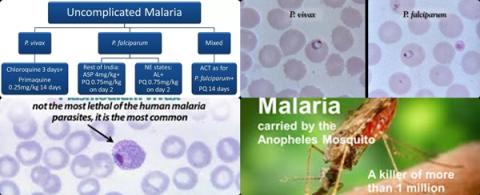
Objectives:
The goal of this review article is to quantify the risk of P vivax parasitaemia after treatment of Plasmodium falciparum with commonly used antimalarial drugs to assess the potential benefits of radical cure for all patients with uncomplicated malaria in co-endemic regions.
Study design:
This review article included 153 studies with a total of 31,262 patients from 323 site-specific treatment groups (from 21 countries): 130 (85%) studies were from the Asia-Pacific region, 16 (10%) from the Americas and 7 (5%) from Africa.
Data for outcomes could be extracted from 106 studies for day 28, 58 studies for day 42 and 12 studies for day 63.
Studies were included if the presence or absence of P vivax parasitaemia was recorded after treatment.
The primary outcome was the risk of P vivax parasitaemia between day 7 and day 42 after initiation of antimalarial treatment for P falciparum, with the pooled risk calculated by random-effects meta-analysis.
There was substantial heterogeneity between study populations.
The mean or median age ranged from 2.9 years to 38.4 years.
Mean or median baseline parasitaemia ranged from 518 to 68 178 parasites per μL.
The prevalence of P falciparum gametocytes at baseline ranged from 0% to 52% and the mean or median baseline haemoglobin ranged from 7.8 g/dL to 14.3 g/dL.
Results and conclusions:
The investigators found the risk of P vivax parasitaemia by day 42 was 5.6% [95% CI = 4.0-7.4, I2 = 92.0%, 117 estimates].
The investigators found the risk of P vivax parasitaemia was 6.5% [95% CI = 4.6-8.6] in regions of short relapse periodicity compared with 1.9% [95% CI = 0.4-4.0] in regions of long periodicity and was greater after treatment with a more rapidly eliminated ACT: 15.3% [95% CI = 5.1-29.3] for artemether-lumefantrine compared with 4.5% [95% CI = 1.2-9.3] for dihydroartemisinin-piperaquine and 5.2% [95% CI = 2.9-7.9] for artesunate-mefloquine.
The investigators found recurrent parasitaemia was delayed in patients treated with ACTs containing mefloquine or piperaquine compared with artemether-lumefantrine, but by day 63 the risk of vivax parasitaemia was more than 15% for all ACTs assessed.
The investigators concluded meta-analysis of 31,262 patients treated for falciparum malaria shows a high risk of subsequent P vivax parasitaemia across a range of co-endemic settings. P vivax parasitaemia occurred more frequently after treatment with rapidly eliminated drugs and in regions with short relapse periodicity. The risk was particularly apparent after treatment with artemether-lumefantrine [15.3% by day 42], accounting for more than half of all recurrent parasitaemias.
These findings suggest that in some regions co-endemic for both P falciparum and P vivax, the introduction of a universal policy of radical cure for all patients with uncomplicated malaria has potential to prevent recurrent parasitaemia, reduce ongoing transmission and enhance malaria elimination efforts.
Original title:
Risk of Plasmodium vivax parasitaemia after Plasmodium falciparum infection: a systematic review and meta-analysis by Commons RJ, Simpson JA, […], Price RN.
Link:
https://www.ncbi.nlm.nih.gov/pmc/articles/PMC6300482/
Additional information of El Mondo:
Find more information/studies on food fortification/malnutrition and malaria right here.